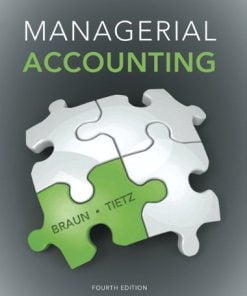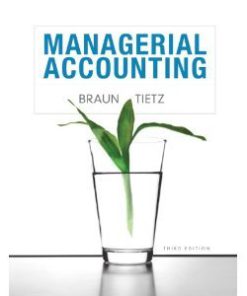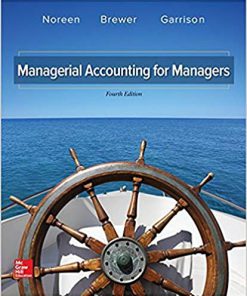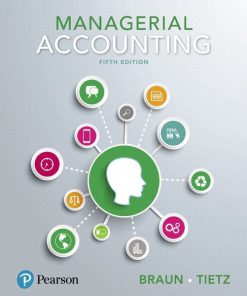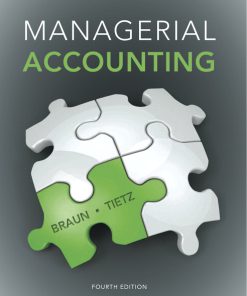Managerial Accounting Braun 4th Edition Test Bank
$35.00 Original price was: $35.00.$26.50Current price is: $26.50.
Managerial Accounting Braun 4th Edition Test Bank
This is completed downloadable of Managerial Accounting Braun 4th Edition Test Bank
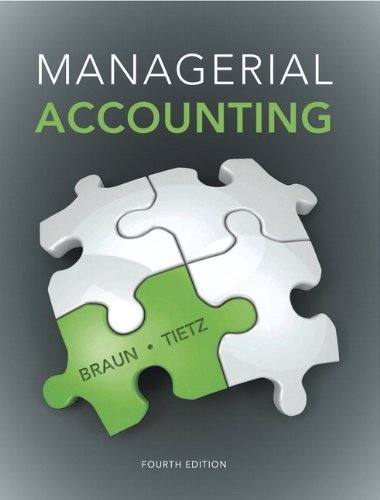
Product Details:
- ISBN-10 : 0133428370
- ISBN-13 : 978-0133428377
- Author: Karen W. Braun, Wendy M. Tietz
Managerial Accounting, Fourth Edition helps students make the connection between managerial accounting concepts and the businesses they deal with everyday through strong coverage and effective practice. By presenting actual accounting decisions made in companies like Target and J. Crew, the text’s precise coverage of the core concepts engages students in the learning process.
MyAccountingLab for Managerial Accounting is an online homework, tutorial, and assessment program that truly engages students in learning. It helps students better prepare for class, quizzes, and exams–resulting in better performance in the course–and provides educators with a dynamic set of tools for gauging individual and class progress.
Table of Content:
- Managerial Accounting
- Copyright
- Contents
- Preface
- Making Connections with Managerial Accounting
- Making Connections Using the Framework for Managerial Accounting
- About the Authors
- Acknowledgments
- 1 Introduction to Managerial Accounting
- 1 Introduction to Managerial Accounting
- What Is Managerial Accounting?
- A Road Map: How Managerial Accounting Fits In
- Differences Between Managerial Accounting and Financial Accounting
- What Role Do Management Accountants Play?
- The Skills Required of Management Accountants
- The Profession of Accounting in Canada
- Ethics
- Examples of Ethical Dilemmas
- Decision Guidelines
- Summary Problem 1
- What Regulatory and Business Issues Affect Today’s Management Accountants?
- International Financial Reporting Standards (IFRS)
- Extensible Business Reporting Language (XBRL)
- Shifting Economy
- How Do Companies Compete in Today’s Global Marketplace?
- Integrated Reporting
- Tools for Time-Based Competition
- Traditional Production Systems
- Lean Production Systems
- Total Quality Management
- How Do Managers Improve Quality?
- Using the Costs of Quality Framework to Aid Decisions
- Decision Guidelines
- Summary Problem 1
- Summary Problem 2
- Decision Guidelines
- Summary Problem 3
- Learning Objectives and Accounting Vocabulary
- Quick Check
- Short Exercises
- Exercises Group A
- Exercises Group B
- Problems Group A
- Problems Group B
- Serial Case
- Capstone Application Problems
- 2 Building Blocks of Managerial Accounting
- 2 Building Blocks of Managerial Accounting
- What Are the Most Common Business Sectors and Their Activities?
- Which Business Activities Make Up the Value Chain?
- Coordinating Activities Across the Value Chain
- How Do Companies Define Cost?
- Costs for Internal Decision Making and External Reporting
- Merchandising Companies’ Inventoriable Product Costs
- Manufacturing Companies’ Inventoriable Product Costs
- Review: Inventoriable Product Costs or Period Costs?
- Prime and Conversion Costs
- Additional Labour Compensation Costs
- Decision Guidelines
- Summary Problem 1
- How Are Inventoriable Product Costs and Period Costs Shown in the Financial Statements?
- Merchandising Companies
- Manufacturing Companies
- Comparing Balance Sheets
- Other Cost Terms Used by Managers
- Relevant and Irrelevant Costs
- Fixed and Variable Costs
- Manufacturing Costs
- Calculating Total and Average Costs
- Decision Guidelines
- Summary Problem 2
- Learning Objectives and Accounting Vocabulary
- Quick Check
- Short Exercises
- Exercises Group A
- Exercises Group B
- Problems Group A
- Problems Group B
- Serial Case
- Capstone Application Problems
- Try It Solutions
- 3 Cost Behaviour
- 3 Cost Behaviour
- Cost Behaviour: How Do Changes in Volume Affect Costs?
- Variable Costs
- Relevant Range
- Fixed Costs
- Mixed Costs
- Changing Costs in the Relevant Range
- Other Cost Behaviours
- Decision Guidelines
- Summary Problem 1
- Determining Cost Behaviour
- High-Low Method
- Regression Analysis
- Predicting Costs
- Data Concerns
- The Contribution Margin Income Statement
- Contribution Margin Income Statements Are Organized by Cost Behaviour
- Decision Guidelines
- Summary Problem 2
- Appendix 3A
- Variable Versus Absorption Costing
- Reconciling the Difference in Income
- Operating Income with Decreasing Inventory
- Comparing Operating Income: Variable Versus Absorption Costing
- Appendix 3B
- Decision Guidelines
- Summary Problem 3
- Learning Objectives and Accounting Vocabulary
- Quick Check
- Short Exercises
- Exercises Group A
- Exercises Group B
- Problems Group A
- Problems Group B
- Serial Case
- Capstone Application Problems
- Try It Solutions
- 4 Cost-Volume-Profit Analysis
- 4 Cost-Volume-Profit Analysis
- Cost-Volume-Profit Analysis
- The Unit Contribution Margin
- The Contribution Margin Ratio
- CVP and the Break-Even Point
- The Shortcut Approach Using the Unit Contribution Margin
- The Shortcut Approach Using the Contribution Margin Ratio
- Calculating the Volume Needed to Earn a Target Profit
- Graphing CVP Relationships
- Decision Guidelines
- Summary Problem 1
- The CVP as a Tool to Plan for Changing Business Conditions
- Changing Variable Costs
- Changing Fixed Costs
- Changing the Mix of Products Offered for Sale
- Common Indicators of Risk
- Operating Leverage
- Decision Guidelines
- Summary Problem 2
- Learning Objectives and Accounting Vocabulary
- Quick Check
- Short Exercises
- Exercises Group A
- Exercises Group B
- Problems Group A
- Problems Group B
- Serial Case
- Capstone Application Problems
- Try It Solutions
- Demo Doc
- 5 Job Costing
- 5 Job Costing
- What Methods Are Used to Determine the Cost of Manufacturing a Product?
- Job Costing
- How Do Manufacturers Determine a Job’s Cost?
- Scheduling Production
- Purchasing Raw Materials
- Using a Job Cost Record to Keep Track of Job Costs
- Tracing Direct Material Costs to a Job
- Tracing Direct Labour Cost to a Job
- Allocating Manufacturing Overhead to a Job
- How Do Managers Deal with Underallocated or Overallocated Manufacturing Overhead?
- Completing the Job Cost Record and Using It to Make Business Decisions
- Decision Guidelines
- Summary Problem 1
- How Do Manufacturers Treat Nonmanufacturing Costs?
- What Journal Entries Are Needed in a Manufacturer’s Job Costing System?
- Purchase of Raw Materials
- Incurring Other Manufacturing Overhead Costs
- Completion of Jobs
- Decision Guidelines
- Summary Problem 2
- Appendix 5A
- Finding the Total Cost of the Job and Adding a Profit Markup
- Learning Objectives and Accounting Vocabulary
- Quick Check
- Short Exercises
- Exercises Group A
- Exercises Group B
- Problems Group A
- Problems Group B
- Serial Case
- Capstone Application Problems
- Try It Solutions
- Demo Doc
- 6 Process Costing
- 6 Process Costing
- Process Costing: An Overview
- How Does the Flow of Costs Differ Between Job and Process Costing?
- The Building Blocks of Process Costing
- Process Costing in the First Processing Department
- The Process Costing Procedure
- Average Unit Costs
- Journal Entries in a Process Costing System
- Decision Guidelines
- Summary Problem 1
- Process Costing in a Second or Later Processing Department
- Process Costing in GogglesPlus’ Insertion Department
- Steps 1 and 2: Summarize the Flow of Physical Units and Compute Output in Terms of Equivalent Units
- Steps 3 and 4: Summarize Total Costs to Account For and Compute the Cost Per Equivalent Unit
- Step 5: Assign Total Costs to Units Completed and to Units in Ending Work in Process Inventory
- Unit Costs and Gross Profit
- Production Cost Reports
- Decision Guidelines
- Summary Problem 2
- Appendix 6A
- Learning Objectives and Accounting Vocabulary
- Quick Check
- Short Exercises
- Exercises Group A
- Exercises Group B
- Problems Group A
- Problems Group B
- Serial Case
- Capstone Application Problems
- Try It Solutions
- Demo Doc
- 7 Activity-Based Costing
- 7 Activity-Based Costing
- Simple Cost Systems and the Potential for Distortion
- Using Departmental Overhead Rates to Allocate Indirect Costs
- Using Activity-Based Costing to Allocate Indirect Costs
- ABC in the Service Industry: Dan’s Dentist Service
- Activity-Based Management (ABM)
- Passing the Cost–Benefit Test
- Decision Guidelines
- Summary Problem 1
- Learning Objectives and Accounting Vocabulary
- Quick Check
- Short Exercises
- Exercises Group A
- Exercises Group B
- Problems Group A
- Problems Group B
- Serial Case
- Capstone Application Problems
- Try It Solution
- 8 Short-Term Business Decisions
- 8 Short-Term Business Decisions
- How Do Managers Make Decisions?
- Regular-Pricing Decisions
- Cost-Plus Pricing
- Target Costing
- Keys to Making Short-Term Special Decisions
- How Do Managers Make Special Business Decisions?
- Decision Guidelines
- Summary Problem 1
- Decisions to Drop Products or Segments
- Other Considerations
- Product Mix Decisions
- Changing Assumptions: Product Mix When Demand Is Limited
- Outsourcing Decisions (Make-or-Buy)
- Sell-As-Is or Process-Further Decisions
- Transfer-Pricing Decisions
- Insufficient Capacity
- Decision Guidelines
- Summary Problem 2
- Learning Objectives and Accounting Vocabulary
- Quick Check
- Short Exercises
- Exercises Group A
- Exercises Group B
- Problems Group A
- Problems Group B
- Serial Case
- Capstone Application Problems
- Try It Solutions
- 9 The Master Budget and Responsibility Accounting
- 9 The Master Budget and Responsibility Accounting
- How and Why Do Managers Use Budgets?
- What Are the Benefits of Budgeting?
- The Master Budget
- How Are the Operating Budgets Prepared?
- Production Budget
- Direct Materials Budget
- Direct Labour Budget
- Manufacturing Overhead Budget
- Operating Expenses Budget
- Budgeted Income Statement
- Decision Guidelines
- Summary Problem 1
- How Are Financial Budgets Prepared?
- Cash Payments Budget
- Combined Cash Budget
- Budgeted Balance Sheet
- Sensitivity Analysis
- What Is Responsibility Accounting?
- Responsibility Accounting Performance Reports
- Decision Guidelines
- Summary Problem 2
- Appendix 9A
- Learning Objectives and Accounting Vocabulary
- Quick Check
- Short Exercises
- Exercises Group A
- Exercises Group B
- Problems Group A
- Problems Group B
- Serial Case
- Capstone Application Problems
- Try It Solutions
- Demo Doc
- 10 Flexible Budgets and Standard Costs
- 10 Flexible Budgets and Standard Costs
- How Do Managers Use Flexible Budgets and Variances?
- How Do Managers Use Standard Costs to Analyze Direct Material and Direct Labour Variances?
- Direct Material Variances
- Direct Labour Variances
- Price and Efficiency Variances: Three Common Pitfalls
- Using Variances
- How Do Managers Use Standard Costs to Analyze Manufacturing Overhead Variances?
- Production Volume Variance
- Overview of Kool-Time’s Manufacturing Overhead Variances
- Decision Guidelines
- Summary Problem 1
- The Static Budget
- The Flexible Budget
- Using Flexible Budgets for Planning
- Using Flexible Budgets to Evaluate Performance
- How Do Managers Compute the Sales Volume Variance and Flexible Budget Variance?
- Sales Volume Variance
- Decision Guidelines
- Summary Problem 2
- Appendix 10A
- Standard Cost Income Statement for Management
- Learning Objectives and Accounting Vocabulary
- Quick Check
- Short Exercises
- Exercises Group A
- Exercises Group B
- Problems Group A
- Problems Group B
- Serial Case
- Capstone Application Problems
- Try It Solutions
- 11 Performance Evaluation and the Balanced Scorecard
- 11 Performance Evaluation and the Balanced Scorecard
- Why Do Companies Decentralize Operations?
- Performance Evaluation Systems
- Limitations of Financial Performance Measurement
- The Four Perspectives of the Balanced Scorecard
- Decision Guidelines
- Summary Problem 1
- Evaluating the Financial Performance of Cost, Revenue, and Profit Centres
- Profit Centre Performance Reports
- Evaluating the Financial Performance of Investment Centres
- Return on Investment (ROI)
- Residual Income (RI)
- Economic Value Added (EVA)
- Limitations of Financial Performance Measures
- Decision Guidelines
- Summary Problem 2
- Appendix 11A
- Learning Objectives and Accounting Vocabulary
- Quick Check
- Short Exercises
- Exercises Group A
- Exercises Group B
- Problems Group A
- Problems Group B
- Serial Case
- Capstone Application Problems
- Try It Solutions
- 12 Capital Investment Decisions and the Time Value of Money
- 12 Capital Investment Decisions and the Time Value of Money
- What Is Capital Budgeting?
- Capital Budgeting Process
- Calculating the Payback Period and Accounting Rate of Return
- Accounting Rate of Return (ARR)
- Decision Guidelines
- Summary Problem 1
- Computing the Time Value of Money
- Future Values and Present Values: Points Along the Time Continuum
- Calculating Future Values of Single Sums and Annuities Using FV Factors
- Calculating Present Values of Single Sums and Annuities Using PV Factors
- Calculating the Net Present Value and Internal Rate of Return
- Capital Rationing and the Profitability Index
- Internal Rate of Return (IRR)
- Capital Budgeting Methods in Comparison
- Decision Guidelines
- Summary Problem 2
- Appendix 12A
- Table B: Present Value of Annuity of $1
- Table C: Future Value of $1
- Table D: Future Value of $1
- Learning Objectives and Accounting Vocabulary
- Quick Check
- Short Exercises
- Exercises Group A
- Exercises Group B
- Problems Group A
- Problems Group B
- Serial Case
- Capstone Application Problems
- Try It Solutions
- 13 Financial Statement Analysis
- 13 Financial Statement Analysis
- What Are the Most Common Methods of Analysis?
- Horizontal Analysis
- Horizontal Analysis of the Income Statement
- Trend Percentages
- Vertical Analysis
- How Do We Compare One Company with Another?
- Decision Guidelines
- Summary Problem 1
- What Are Some of the Most Common Financial Ratios?
- Measuring Ability to Sell Inventory and Collect Receivables
- Measuring Ability to Pay Long-Term Debt
- Measuring Profitability
- Analyzing Share Investments
- Red Flags in Financial Statement Analysis
- Decision Guidelines
- Summary Problem 2
- Learning Objectives and Accounting Vocabulary
- Quick Check
- Short Exercises
- Exercises Group A
- Exercises Group B
- Problems Group A
- Problems Group B
- Critical Thinking
- Application & Analysis Mini Cases
- Team Project
- Try It Solutions
People Also Search:
managerial accounting 4th edition braun solutions manual
managerial accounting 4th edition
managerial accounting braun
You may also like…
Solution Manual
Solution Manual
Solution Manual




